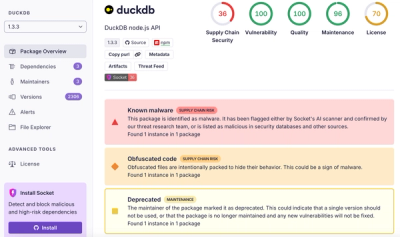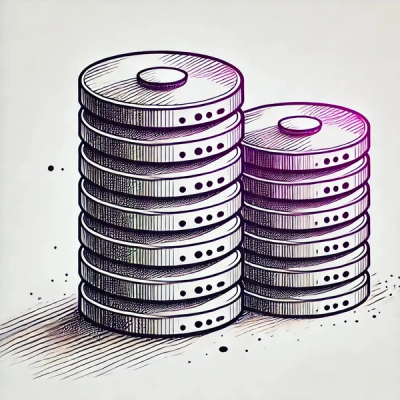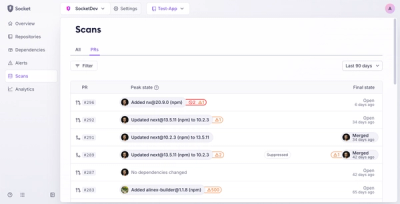
Research
/Security News
DuckDB npm Account Compromised in Continuing Supply Chain Attack
Ongoing npm supply chain attack spreads to DuckDB: multiple packages compromised with the same wallet-drainer malware.
@utsubo/lamina
Advanced tools
These demos are real, you can click them! They contain the full code, too. 📦 More examples here
lamina lets you create materials with a declarative, system of layers. Layers make it incredibly easy to stack and blend effects. This approach was first made popular by the Spline team.
import { LayerMaterial, Depth } from 'lamina'
function GradientSphere() {
return (
<Sphere>
<LayerMaterial
color="#ffffff" //
lighting="physical"
transmission={1}
>
<Depth
colorA="#810000" //
colorB="#ffd0d0"
alpha={0.5}
mode="multiply"
near={0}
far={2}
origin={[1, 1, 1]}
/>
</LayerMaterial>
</Sphere>
)
}
Lamina can be used with vanilla Three.js. Each layer is just a class.
import { LayerMaterial, Depth } from 'lamina/vanilla'
const geometry = new THREE.SphereGeometry(1, 128, 64)
const material = new LayerMaterial({
color: '#d9d9d9',
lighting: 'physical',
transmission: 1,
layers: [
new Depth({
colorA: '#002f4b',
colorB: '#f2fdff',
alpha: 0.5,
mode: 'multiply',
near: 0,
far: 2,
origin: new THREE.Vector3(1, 1, 1),
}),
],
})
const mesh = new THREE.Mesh(geometry, material)
Note: To match the colors of the react example, you must convert all colors to Linear encoding like so:
new Depth({
colorA: new THREE.Color('#002f4b').convertSRGBToLinear(),
colorB: new THREE.Color('#f2fdff').convertSRGBToLinear(),
alpha: 0.5,
mode: 'multiply',
near: 0,
far: 2,
origin: new THREE.Vector3(1, 1, 1),
}),
LayerMaterialLayerMaterial can take in the following parameters:
| Prop | Type | Default |
|---|---|---|
name | string | "LayerMaterial" |
color | THREE.ColorRepresentation | THREE.Color | "white" |
alpha | number | 1 |
lighting | 'phong' | 'physical' | 'toon' | 'basic' | 'lambert' | 'standard' | 'basic' |
layers* | Abstract[] | [] |
The lighting prop controls the shading that is applied on the material. The material then accepts all the material properties supported by ThreeJS of the material type specified by the lighting prop.
* Note: the layers prop is only available on the LayerMaterial class, not the component. Pass in layers as children in React.
Here are the layers that lamina currently provides
| Name | Function |
|---|---|
| Fragment Layers | |
Color | Flat color. |
Depth | Depth based gradient. |
Fresnel | Fresnel shading (strip or rim-lights). |
Gradient | Linear gradient. |
Matcap | Load in a Matcap. |
Noise | White, perlin or simplex noise . |
Normal | Visualize vertex normals. |
Texture | Image texture. |
| Vertex Layers | |
Displace | Displace vertices using. noise |
See the section for each layer for the options on it.
Lamina comes with a handy debugger that lets you tweek parameters till you're satisfied with the result! Then, just copy the JSX and paste!
Replace LayerMaterial with DebugLayerMaterial to enable it.
<DebugLayerMaterial color="#ffffff">
<Depth
colorA="#810000" //
colorB="#ffd0d0"
alpha={0.5}
mode="multiply"
near={0}
far={2}
origin={[1, 1, 1]}
/>
</DebugLayerMaterial>
Any custom layers are automatically compatible with the debugger. However, for advanced inputs, see the Advanced Usage section.
You can write your own layers by extending the Abstract class. The concept is simple:
Each layer can be treated as an isolated shader program that produces a
vec4color.
The color of each layer will be blended together using the specified blend mode. A list of all available blend modes can be found here
import { Abstract } from 'lamina/vanilla'
// Extend the Abstract layer
class CustomLayer extends Abstract {
// Define stuff as static properties!
// Uniforms: Must begin with prefix "u_".
// Assign them their default value.
// Any unifroms here will automatically be set as properties on the class as setters and getters.
// There setters and getters will update the underlying unifrom.
static u_color = 'red' // Can be accessed as CustomLayer.color
static u_alpha = 1 // Can be accessed as CustomLayer.alpha
// Define your fragment shader just like you already do!
// Only difference is, you must return the final color of this layer
static fragmentShader = `
uniform vec3 u_color;
uniform float u_alpha;
// Varyings must be prefixed by "v_"
varying vec3 v_Position;
vec4 main() {
// Local variables must be prefixed by "f_"
vec4 f_color = vec4(u_color, u_alpha);
return f_color;
}
`
// Optionally Define a vertex shader!
// Same rules as fragment shaders, except no blend modes.
// Return a non-projected vec3 position.
static vertexShader = `
// Varyings must be prefixed by "v_"
varying vec3 v_Position;
void main() {
v_Position = position;
return position * 2.;
}
`
constructor(props) {
// You MUST call `super` with the current constructor as the first argument.
// Second argument is optional and provides non-uniform parameters like blend mode, name and visibility.
super(CustomLayer, {
name: 'CustomLayer',
...props,
})
}
}
👉 Note: The vertex shader must return a vec3. You do not need to set gl_Position or transform the model view. lamina will handle this automatically down the chain.
👉 Note: You can use lamina's noise functions inside of your own layer without any additional imports: lamina_noise_perlin(), lamina_noise_simplex(), lamina_noise_worley(), lamina_noise_white(), lamina_noise_swirl().
If you need a specialized or advance use-case, see the Advanced Usage section
Custom layers are Vanilla compatible by default.
To use them with React-three-fiber, you must use the extend function to add the layer to your component library!
import { extend } from "@react-three/fiber"
extend({ CustomLayer })
// ...
const ref = useRef();
// Animate uniforms using a ref.
useFrame(({ clock }) => {
ref.current.color.setRGB(
Math.sin(clock.elapsedTime),
Math.cos(clock.elapsedTime),
Math.sin(clock.elapsedTime),
)
})
<LayerMaterial>
<customLayer
ref={ref} // Imperative instance of CustomLayer. Can be used to animate unifroms
color="green" // Uniforms can be set directly
alpha={0.5}
/>
</LayerMaterial>
For more advanced custom layers, lamina provides the onParse event.
This event runs after the layer's shader and uniforms are parsed.
This means you can use it to inject functionality that isn't by the basic layer extension syntax.
Here is a common use case - Adding non-uniform options to layers that directly sub out shader code.
class CustomLayer extends Abstract {
static u_color = 'red'
static u_alpha = 1
static vertexShader = `...`
static fragmentShader = `
// ...
float f_dist = lamina_mapping_template; // Temp value, will be used to inject code later on.
// ...
`
// Get some shader code based off mapping parameter
static getMapping(mapping) {
switch (mapping) {
default:
case 'uv':
return `some_shader_code`
case 'world':
return `some_other_shader_code`
}
}
// Set non-uniform defaults.
mapping: 'uv' | 'world' = 'uv'
// Non unifrom params must be passed to the constructor
constructor(props) {
super(
CustomLayer,
{
name: 'CustomLayer',
...props,
},
// This is onParse callback
(self: CustomLayer) => {
// Add to Leva (debugger) schema.
// This will create a dropdown select component on the debugger.
self.schema.push({
value: self.mapping,
label: 'mapping',
options: ['uv', 'world'],
})
// Get shader chunk based off selected mapping value
const mapping = CustomLayer.getMapping(self.mapping)
// Inject shader chunk in current layer's shader code
self.fragmentShader = self.fragmentShader.replace('lamina_mapping_template', mapping)
}
)
}
}
In react...
// ...
<LayerMaterial>
<customLayer
ref={ref}
color="green"
alpha={0.5}
args={[mapping]} // Non unifrom params must be passed to the constructor using `args`
/>
</LayerMaterial>
Every layer has these props in common.
| Prop | Type | Default |
|---|---|---|
mode | BlendMode | "normal" |
name | string | <this.constructor.name> |
visible | boolean | true |
All props are optional.
ColorFlat color.
| Prop | Type | Default |
|---|---|---|
color | THREE.ColorRepresentation | THREE.Color | "red" |
alpha | number | 1 |
NormalVisualize vertex normals
| Prop | Type | Default |
|---|---|---|
direction | THREE.Vector3 | [number,number,number] | [0, 0, 0] |
alpha | number | 1 |
DepthDepth based gradient. Colors are lerp-ed based on mapping props which may have the following values:
vector: distance from origin to fragment's world position.camera: distance from camera to fragment's world position.world: distance from fragment to center (0, 0, 0).| Prop | Type | Default |
|---|---|---|
colorA | THREE.ColorRepresentation | THREE.Color | "white" |
colorB | THREE.ColorRepresentation | THREE.Color | "black" |
alpha | number | 1 |
near | number | 2 |
far | number | 10 |
origin | THREE.Vector3 | [number,number,number] | [0, 0, 0] |
mapping | "vector" | "camera" | "world" | "vector" |
FresnelFresnel shading.
| Prop | Type | Default |
|---|---|---|
color | THREE.ColorRepresentation | THREE.Color | "white" |
alpha | number | 1 |
power | number | 0 |
intensity | number | 1 |
bias | number | 2 |
GradientLinear gradient based off distance from start to end in a specified axes. start and end are points on the axes selected. The distance between start and end is used to lerp the colors.
| Prop | Type | Default |
|---|---|---|
colorA | THREE.ColorRepresentation | THREE.Color | "white" |
colorB | THREE.ColorRepresentation | THREE.Color | "black" |
alpha | number | 1 |
contrast | number | 1 |
start | number | 1 |
end | number | -1 |
axes | "x" | "y" | "z" | "x" |
mapping | "local" | "world" | "uv" | "local" |
NoiseVarious noise functions.
| Prop | Type | Default |
|---|---|---|
colorA | THREE.ColorRepresentation | THREE.Color | "white" |
colorB | THREE.ColorRepresentation | THREE.Color | "black" |
colorC | THREE.ColorRepresentation | THREE.Color | "white" |
colorD | THREE.ColorRepresentation | THREE.Color | "black" |
alpha | number | 1 |
scale | number | 1 |
offset | THREE.Vector3 | [number, number, number] | [0, 0, 0] |
mapping | "local" | "world" | "uv" | "local" |
type | "perlin' | "simplex" | "cell" | "curl" | "perlin" |
MatcapSet a Matcap texture.
| Prop | Type | Default |
|---|---|---|
map | THREE.Texture | undefined |
alpha | number | 1 |
TextureSet a texture.
| Prop | Type | Default |
|---|---|---|
map | THREE.Texture | undefined |
alpha | number | 1 |
BlendModeBlend modes currently available in lamina
normal | divide |
|---|---|
add | overlay |
subtract | screen |
multiply | softlight |
lighten | reflect |
darken | negation |
Layers that affect the vertex shader
DisplaceDisplace vertices with various noise.
| Prop | Type | Default |
|---|---|---|
strength | number | 1 |
scale | number | 1 |
mapping | "local" | "world" | "uv" | "local" |
type | "perlin' | "simplex" | "cell" | "curl" | "perlin" |
offset | THREE.Vector3 | [number,number,number] | [0, 0, 0] |
FAQs
🍰 An extensable, layer based shader material for ThreeJS.
We found that @utsubo/lamina demonstrated a not healthy version release cadence and project activity because the last version was released a year ago. It has 3 open source maintainers collaborating on the project.
Did you know?

Socket for GitHub automatically highlights issues in each pull request and monitors the health of all your open source dependencies. Discover the contents of your packages and block harmful activity before you install or update your dependencies.

Research
/Security News
Ongoing npm supply chain attack spreads to DuckDB: multiple packages compromised with the same wallet-drainer malware.

Security News
The MCP Steering Committee has launched the official MCP Registry in preview, a central hub for discovering and publishing MCP servers.

Product
Socket’s new Pull Request Stories give security teams clear visibility into dependency risks and outcomes across scanned pull requests.